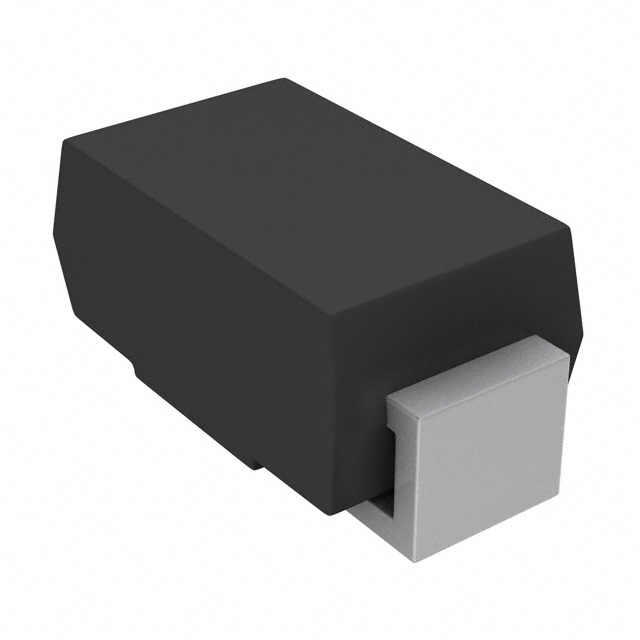Viz Specifikace pro podrobnosti o produktu.

SMA6J16A-M3/5A
Product Overview
Category
The SMA6J16A-M3/5A belongs to the category of semiconductor devices, specifically a type of TVS (transient voltage suppressor) diode.
Use
This product is commonly used for surge protection in electronic circuits and systems to safeguard against transient voltage spikes.
Characteristics
- Package: SMA (DO-214AC)
- Essence: Transient voltage suppression
- Packaging/Quantity: Available in tape and reel packaging, with quantities varying based on supplier and customer requirements.
Specifications
- Voltage Rating: 16V
- Power Dissipation: 600W
- Breakdown Voltage: 17.8V
- Clamping Voltage: 25.2V
- Peak Pulse Current: 23.3A
- Operating Temperature Range: -55°C to +150°C
Detailed Pin Configuration
The SMA6J16A-M3/5A has two pins, with the anode connected to the positive side and the cathode connected to the negative side of the circuit.
Functional Features
- Fast response time
- Low clamping voltage
- High surge current capability
- RoHS compliant
Advantages and Disadvantages
Advantages
- Effective protection against transient voltage spikes
- Fast response time ensures minimal damage to protected circuits
- Compact size for easy integration into circuit designs
Disadvantages
- Limited to low voltage applications
- May require additional components for comprehensive surge protection in high-power systems
Working Principles
The SMA6J16A-M3/5A operates by diverting excess voltage away from sensitive components in the circuit, thereby preventing damage due to transient voltage spikes. When a surge occurs, the diode rapidly conducts, providing a low-resistance path for the excess energy to be safely dissipated.
Detailed Application Field Plans
This TVS diode is widely used in various electronic systems, including: - Consumer electronics - Telecommunications equipment - Automotive electronics - Industrial control systems - Power supplies
Detailed and Complete Alternative Models
- SMA6J10A-M3/5A: 10V voltage rating
- SMA6J13A-M3/5A: 13V voltage rating
- SMA6J18A-M3/5A: 18V voltage rating
- SMA6J24A-M3/5A: 24V voltage rating
In conclusion, the SMA6J16A-M3/5A TVS diode offers effective surge protection for a wide range of electronic applications, with its fast response time and compact design making it a popular choice for circuit protection needs.
Word Count: 398
Seznam 10 běžných otázek a odpovědí souvisejících s aplikací SMA6J16A-M3/5A v technických řešeních
What is the maximum voltage rating of SMA6J16A-M3/5A?
- The maximum voltage rating of SMA6J16A-M3/5A is 16V.
What is the peak pulse power dissipation of SMA6J16A-M3/5A?
- The peak pulse power dissipation of SMA6J16A-M3/5A is 600W.
What is the typical clamping voltage of SMA6J16A-M3/5A?
- The typical clamping voltage of SMA6J16A-M3/5A is 25.6V at 10A.
What are the typical applications for SMA6J16A-M3/5A?
- SMA6J16A-M3/5A is commonly used in surge protection for sensitive electronics, such as in telecommunications equipment, industrial control systems, and automotive electronics.
What is the operating temperature range of SMA6J16A-M3/5A?
- The operating temperature range of SMA6J16A-M3/5A is -55°C to +150°C.
Is SMA6J16A-M3/5A RoHS compliant?
- Yes, SMA6J16A-M3/5A is RoHS compliant.
What is the package type of SMA6J16A-M3/5A?
- SMA6J16A-M3/5A is available in a DO-214AC (SMA) package.
Does SMA6J16A-M3/5A have a low leakage current?
- Yes, SMA6J16A-M3/5A has a low leakage current, which makes it suitable for battery-powered applications.
Can SMA6J16A-M3/5A be used for ESD protection?
- Yes, SMA6J16A-M3/5A can be used for ESD (electrostatic discharge) protection in various electronic devices.
Are there any recommended layout considerations for using SMA6J16A-M3/5A?
- It is recommended to minimize the length of the PCB traces connecting SMA6J16A-M3/5A to the circuitry it is protecting and to provide a low-inductance path to ground for optimal performance.

